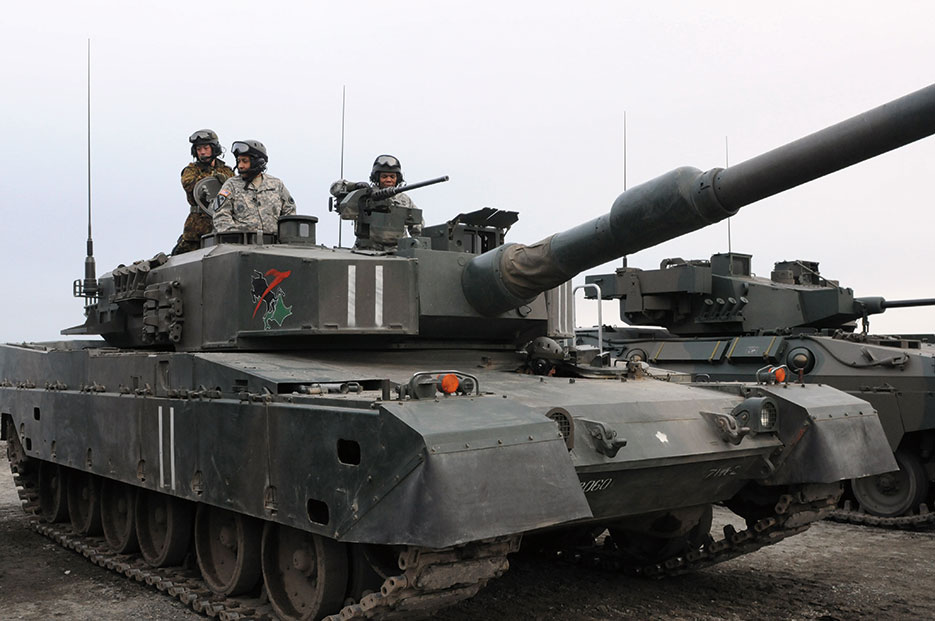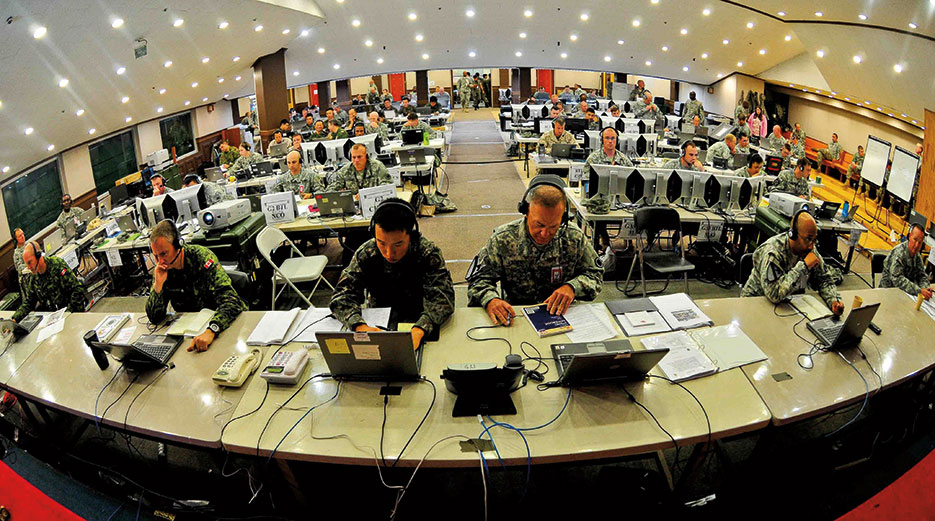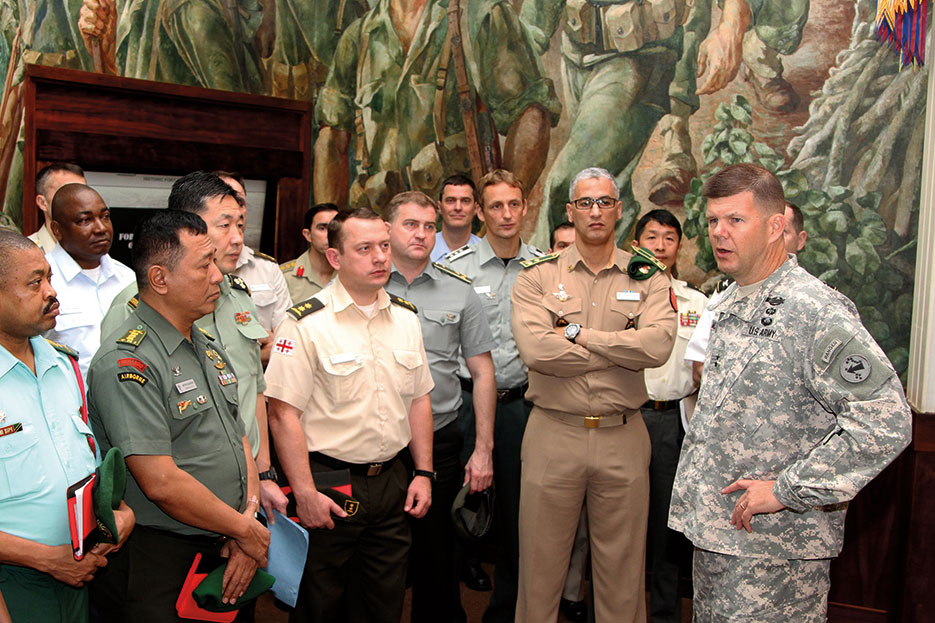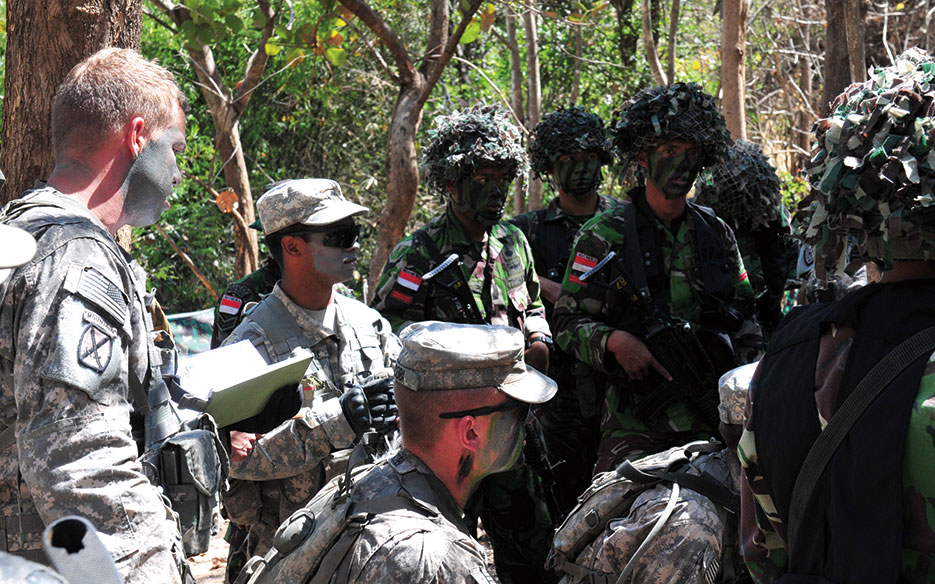Журнальный клуб Интелрос » Joint Force Quarterly » №77, 2015
We will of necessity rebalance toward the Asia-Pacific region. Our relationships with Asian allies and key partners are critical to the future stability and growth of the region.1
In January 2012, the United States redefined its global security priorities with the words above. The changing global environment, signified by the rising political and economic power of Asia, necessitated an adjustment of national strategic goals. On the surface, little may appear changed in a region mostly covered with blue water. Army forces are still in Korea, Japan, and Hawaii. That surface view belies the strategic, operational, and tactical changes that have occurred as the Army’s direction has shifted to the Pacific, spearheaded operationally by I Corps.
The U.S. military learned a great deal from the past 12 years of war in Iraq and Afghanistan. Among these lessons was the necessity of joint operations and coordination with unified action partners. Joint Publication 3-0, Joint Operations, summarizes the need for joint operations:
To succeed, we will need adaptive and thinking professionals who understand the capabilities their Service brings to joint operations: how to integrate those capabilities with those of other Services and inter-organizational partners to optimize the strength of unified action: and how to organize, employ, and sustain joint forces to provide national leaders with multiple options for addressing various security threats.2
In addition to working with joint partners, the U.S. military must collaborate with its unified action partners as it attempts to plan, coordinate, synchronize, and integrate the activities of governmental and nongovernmental entities with military operations to achieve unity of effort.3
The I Corps assignment to U.S. Pacific Command (USPACOM) underscores the Army’s commitment to the Pacific region. The addition of an assigned Army corps provides a tailorable, scalable, and agile mission command node as well as unique capability sets that add to USPACOM capabilities to prevent, shape, and win in the region. I Corps increases the options available to USPACOM at the tactical and operational levels. After outlining the importance of the Pacific region, this article focuses on the efforts of I Corps as the Army’s only corps assigned to a geographic combatant commander and within the larger Army efforts to rebalance strategically, operationally, and tactically.

I Corps senior enlisted leader and U.S. Army–Japan senior enlisted leader test-drive Japanese Type 90 tank at Camp Higashi-Chitose, Japan, on study tour during Yama Sakura 65 (U.S. Army/Chalon Hutson)
The Indo-Pacific region spans half the globe and directly influences the U.S. economy and security. The world’s three largest economies reside in the USPACOM area of responsibility (AOR), and the area’s global economic importance is significant.4 Eight trillion dollars of annual two-way trade moves through the region. At any moment, one of every two of the world’s cargo ships and two of every three ships carrying energy assets are traveling through USPACOM. The area is home to four of the world’s most populous countries, seven of the world’s largest armies, and five of the seven U.S. Mutual Defense Agreements.5 Security cooperation with our allies in Australia, Japan, the Philippines, South Korea, and Thailand is regionally important, and the overall security situation in the region has global effects on trade and economic prosperity. These facts alone make a compelling case for the military interest in the Pacific region.
The Marine Corps, Navy, and Air Force have—and will continue to have—huge roles in achieving the goals stated in the 2010 National Security Strategy. The expeditionary capability of the Marine Corps and Navy to project power in littoral areas and promote security in waterways is unmatched. Army forces also provide valuable combat and support capabilities necessary to achieve regional goals. Rather than set the Army and Marine Corps into a competition in the Pacific, regionally aligned Army corps and subordinate units add vital and complementary capabilities to the joint force. Cooperation and collaboration are necessary to increase the interoperability between Army, Marine Corps, Navy, and Air Force forces. Increased security of this vital portion of the world is well worth the effort.
Twenty-one of the 27 Pacific nations with militaries chose army officers, not admirals or air force officers, as their defense chiefs. That choice suggests a security mindset that the United States must recognize as it seeks to deepen relationships and enhance regional security. Even across language barriers, our common profession as army officers serves as a bridge to mutual understanding and respect. Partnership skills developed over the past 12 years with the armies of Iraq, Afghanistan, and fellow coalition forces will enable the Soldiers of I Corps to develop relationships with our partner armies in the Pacific.
Relationships developed between countries during military-to-military engagements and exercises are an important first step in the Army’s ability to prevent conflcit and shape the region. Exercises build confidence, trust, and interoperability between the U.S. military and our Pacific partners through a consistent regional partnership program. They prevent conflict by demonstrating the capabilities of the U.S. military as a reliable partner, engaged and focused on creating a stable security environment. Military-to-military engagements shape the region by increasing our Pacific partners’ ability to provide security and are a visible demonstration of combined strength. The shared experiences ensure that partner nations understand each other’s capabilities and systems and have trust in one another before conducting combined operations during a crisis.

Staff briefs I Corps commander during combined arms rehearsal meeting for U.S.–South Korean annual joint/combined command post exercise Ulchi Freedom Guardian (DOD/Daniel Schroeder)
Designating the U.S. Army Pacific (USARPAC) commander as a four-star general was a major strategic shift in the command structure of the Pacific Army. This change allowed USPACOM to designate the USARPAC as the Theater Joint Force Land Component Command (JFLCC) for the Pacific region. The new mission command architecture added a more robust theater capability for sustainment, communications, and medical support to respond to the range of military operations in the Pacific.
The elevation of USARPAC to a four-star command created an opportunity for I Corps to expand its role in the region. I Corps is the first operational-level headquarters assigned to a geographic combatant commander in the regionally aligned forces concept. This headquarters has completed an operational capabilities assessment, which certifies it to serve as a joint task force headquarters under USPACOM.6
At the tactical level, the Army redefined command and support relationships between U.S. Army Forces Command (USFORCOM) and USARPAC units. The 7th Infantry Division and 593rd Expeditionary Sustainment Command now command nine of the Joint Base Lewis-McChord–based brigades, all of which are aligned to the Pacific, thus enabling I Corps to maintain a mission focus on the Pacific. As the operational arm of USARPAC, I Corps now has operational control of the 25th Infantry Division, a coordinating relationship with U.S. Army Alaska and U.S. Army Japan, and operational control of the Alaska-based brigades for missions outside of Alaska.
Strategic, operational, and tactical changes to the mission command structure in the Pacific allow I Corps to provide an operational planning capability, reduce headquarters redundancy, and provide sound three-star level solutions to USARPAC and USPACOM.
An Army corps headquarters provides a scalable, tailorable, and agile mission command node that has the capability to respond to crises of varying size and duration. The headquarters can tailor and scale itself to the appropriate size and capability set based on the situation. To illustrate that point, elements of I Corps participated in six major exercises in 2013. Three of the six exercises are of particular note as they challenged the corps headquarters to execute operations as a Combined Force Land Component Command (CFLCC), traditional U.S. Army corps, and JFLCC.
In July 2013, I Corps participated in Exercise Talisman Saber with our Australian counterparts in the 1st Australian Division and U.S. Third Fleet, with its Seventh Fleet as the higher headquarters. I Corps deployed its early entry command post (EECP) scaled and tailored to serve as the CFLCC, and it was during this exercise that the headquarters executed its joint task force certification. Admiral Samuel Locklear, commander of USPACOM, noted that I Corps was a “tailorable, agile, operational headquarters ready for deployment across the spectrum of operations.”7
During this exercise, I Corps provided mission command to two U.S. National Guard Divisions, the Australian 1st Division, the 3rd Marine Expeditionary Brigade, and the 4thBrigade (Airborne) of the 25th Infantry Division. These units were operating in Phases II, III, and IV across a noncontiguous area of operations that stretched the same approximate distance as Iraq to Afghanistan. Of particular note, over 400 paratroopers in five C-17s flew 15 hours straight from Joint Base Elmendorf-Richardson, Alaska, and conducted a joint forcible entry operation north of Rockhampton, Australia. This strategic airdrop demonstrated the ability of a joint and multinational force to project power from the U.S. mainland to anywhere in the Pacific region.
Shortly after Talisman Saber, I Corps participated in Exercise Ulchi Freedom Guardian in August 2013. I Corps deployed a smaller EECP scaled and tailored for service as a traditional U.S. Army corps under the Third Republic of Korea Army. I Corps faced a decisive action scenario complex in its requirements for combined and joint major combat operations, which ensured that the corps is capable of effectively and efficiently operating at the highest end of the range of military operations.
Always learning and growing, I Corps participated in Exercise Yama Sakura 65 in December 2013 alongside our partners, the Japan Ground Self-Defense Force. In this exercise, the corps deployed a robust EECP scaled to 400 of the corps staff and 50 Reserve and joint augmentees, and integrated the I Corps (Forward)/U.S. Army Japan commander as a deputy commanding general. The corps tailored itself to operate as a JFLCC alongside Japan’s Ground Self-Defense Force Northern Army. This unique bilateral environment, coupled with the exercise’s unified action complexity, put a premium on building a cohesive team, creating shared understanding, and developing mutual trust.
Through exercises such as Talisman Saber, Ulchi Freedom Guardian, and Yama Sakura 65, I Corps has proved itself as a headquarters that offers operational solutions to USARPAC and USPACOM commanders. Significantly, a corps headquarters, certified as a joint task force and with recent operational-level experience in Afghanistan, provides these commanders with a headquarters capable of conducting mission command in any situation and in various command capacities within the Pacific region.

U.S. Army Pacific chief of staff welcomed 39 senior leaders participating in U.S. Army War College International Fellows program to Fort Shafter, Hawaii (U.S. Army/Kyle J. Richardson)
The regional alignment of an Army corps and subordinate units gives a tremendous amount of flexibility to the USPACOM commander to be able to support the entire range of military operations. Regionally aligned forces execute theater security cooperation activities, bilateral and multilateral military exercises, and operations support. They provide the combatant commander with forces that can respond to crises and have the necessary language capability and regional expertise.
The realignment of command and support relationships between I Corps, 25th Infantry Division, U.S. Army Alaska, and U.S. Army Japan brings an amazing amount of capability to the Pacific. In addition to the two organic Stryker brigades, I Corps now has four additional brigade combat teams at its disposal for contingency operations. These maneuver brigade combat teams bring more depth to the already robust amount of land combat power resident in the U.S. Marine Forces Pacific.
Perhaps more importantly, Army assets such as aviation, engineer, civil affairs, military police, surveillance, logistics, communications, and medical will provide critical expertise and capabilities during contingency operations. The addition of these U.S. Army resources to elements already resident in the Pacific will allow USPACOM to respond to any contingency for an extended duration with the numbers and types of tools needed for success.
USARPAC developed a new concept called Pacific Pathways that supports both regional operational contingencies and tactical training needs. Army forces operating in the region will be able to collaborate with Pacific partner military forces for training and be responsive to developing crises. Pacific Pathways supports the current engagement strategy of “assure, promote, enhance, open, sustain,” and puts the most highly trained units closest to potential crisis.8 The I Corps role in executing Pacific Pathways is to provide training and readiness authority over units executing Pathways, to resource solutions for USARPAC, and to mission command the units executing Pathways.
In July 2014, a single Joint Base Lewis-McChord Stryker brigade combat team conducted a Pathways proof of principle. The unit chosen to execute the first Pacific Pathways mission was one of the seven brigades of the Army Contingency Force. Its selection was a deliberate decision to dedicate a unit at the highest state of readiness toward the rebalance to the Pacific. The brigade task-organized to accomplish the objectives of the major exercises, facilitated continued military-to-military engagements in the Pacific region, and provided rapidly deployable options for USPACOM in response to emerging situations. The task force elements were a mission command headquarters (battalion or brigade), tactical force, aviation, support, and enabling elements.9
Under the Pacific Pathways concept, a brigade will spend 2 to 3 months in the USPACOM AOR following a combat training center rotation. Once the Pathways mission begins, the 25th Infantry Division will assume mission command of the brigade for the duration of the three exercises and for any contingency operations. After it has completed its Pathways missions, this highly trained unit will then be available to USPACOM to respond to emerging contingency operations in the Pacific.10

Indonesian National Armed Forces and U.S. Army Soldiers receive tactical briefing during field training exercise Garuda Shield 2014 (U.S. Army/Matthew Veasley)
I Corps recognizes that a major challenge to operating in such a vast region is the development of long-term, meaningful relationships with our Pacific security partners. Annual exercises and the Pacific Pathways initiative are examples of efforts to prevent and shape in the Pacific, and they are opportunities to build and maintain critical relationships. The development of leaders capable of executing at the operational and strategic levels is the goal of the I Corps plan. These leaders must have the language and the regional expertise to understand the geopolitical context of the operating environment, and they must integrate with unified action partners in government, nongovernmental agencies, and our Pacific military partners.
It is to that end that I Corps created a biannual Senior Leader Development Training program for our military senior leaders and leaders from our Pacific partner nations. The most recent 2-day event focused on organizational leadership and humanitarian assistance/disaster relief. Partner agencies included the Army, Navy, Air Force, Army National Guard, Reserve, Coast Guard, U.S. Agency for International Development, and the Japan Ground Self-Defense Force. Executives from Microsoft, Northrop Grumman, Boeing, Amazon, and the American Red Cross also contributed to the training experience. This diverse audience generated thoughtful discussions and built cross-organizational relationships as they grappled with the issues, developed a better understanding of alternate perspectives, and learned from shared experiences.
Efforts to build tactical expertise in the Pacific region have not stopped with leader development training. I Corps and I Marine Expeditionary Force are also planning to co-host the Land Power in the Asia-Pacific workshop, which will examine the role of ground power in America’s rebalance to the Pacific. Through presentations, panel discussions, and breakout groups, senior Army and Marine Corps leaders will develop a shared understanding of the role for land power in the region. The workshop will specifically focus on the Asia-Pacific security environment, capability requirements, and the challenges to rebalance.
In addition, the Joint Base Lewis-McChord Language and Culture Center is a valuable resource for I Corps leaders to assist them in understanding the human domain of the Pacific region. It provides language, regional expertise, and culture training designed to equip Soldiers with mission-critical language and cultural information. Commanders prepare themselves and their units for intercultural interactions by selecting from a full range of language and culture training. Training tailored to specific mission requirements includes facilitated or self-paced cross-cultural communication classes, language familiarization courses, culture-specific training, and area orientation briefings. I Corps leaders recognize the operational benefits stemming from language and culture training as a way to enhance their unit’s ability to communicate across cultures. They also appreciate the importance of the human aspect of operations within the Pacific region as a means to build lasting relationships with our Pacific partners and bolster regional security.
Through the joint warfighting capability, along with our unified action partners, the U.S. military is postured to provide security force assistance and contingency support to its Pacific partners. Considering that the USPACOM AOR makes up nearly one-half of the entire world, it is necessary that all Services be brought together to amplify their respective capabilities. The effective mixture of the Army, Marine Corps, Navy, Air Force, and capabilities in USPACOM is truly an amazing and unmatched effort to achieve national strategic goals in the region.
As part of the rebalance to the Pacific, the Army has made strategic, operational, and tactical adjustments to the regional mission command architecture. The elevation of USARPAC to four-star status, regional alignment of I Corps to the Pacific, and realignment of the subordinate command structure signify the Army’s commitment to the region. The additional Army functional and multifunctional brigades lend depth to the capabilities long resident in the Pacific.
Finally, the certification of I Corps as a joint task force capable of executing mission command as an Army corps, Combined or Joint Force Land Component Command, or joint task force gives the combatant commander more options when responding to crises in the Pacific. Rather than set the Services into a competition, the additional Army capabilities are complementary to those already in the region and enhance the military’s ability to accomplish the security priorities laid out by the President in January 2012.JFQ